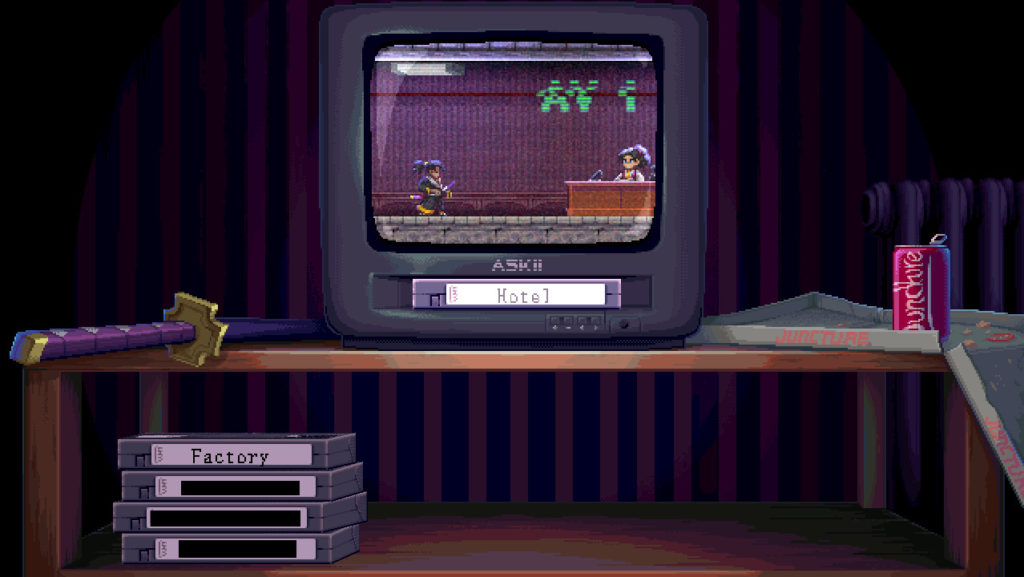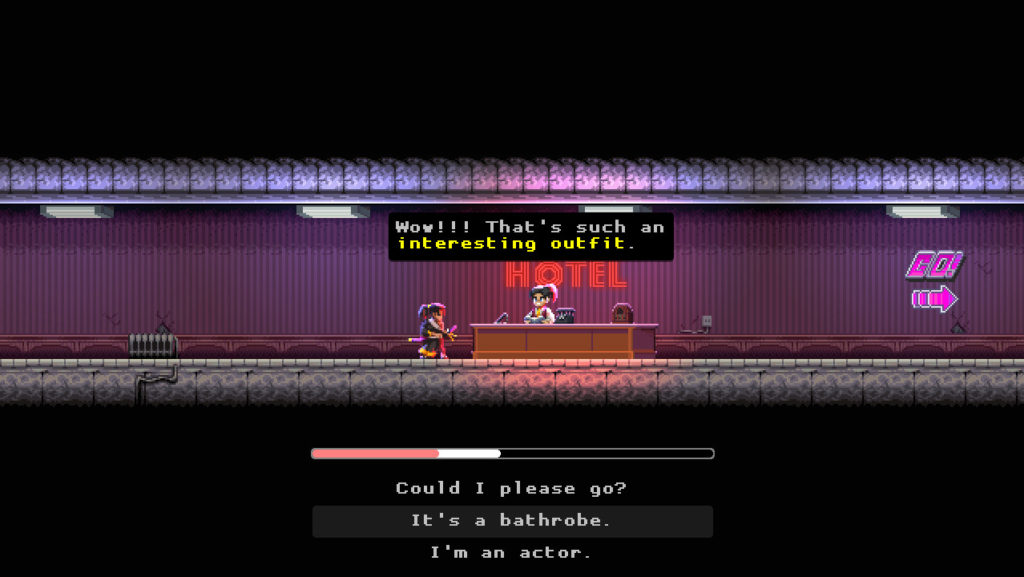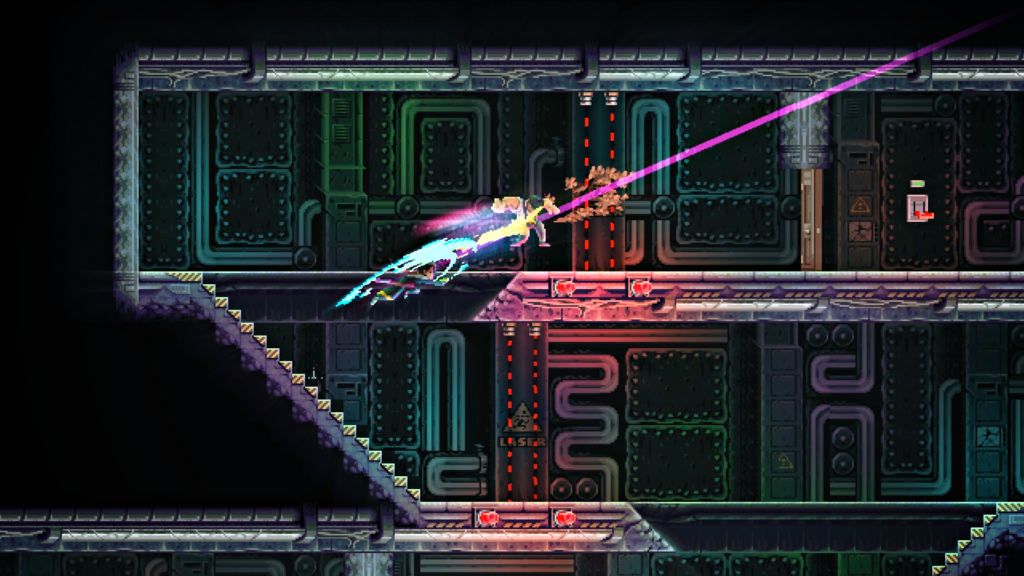
Katana Zero: Playing with Time to Fix a Fractured Memory
There is something about how Askiisoft’s Katana Zero uses the “unreliable narrator” device that works with me—rather than misdirecting the player with ludicrous and unearned twists in a linear plot, this game makes the player feel active in the story. The protagonist of this game, a katana-wielding assassin named Agent Zero, is trying to piece the echoes of his memory back together, and the player has an unusual amount of agency in how he goes about achieving this.
Understanding the framing of Katana Zero requires a bit of guesswork; it is a 2D sidescrolling action game that splits its chapters into different screens or levels, each with a number of enemies and obstacles that must be dispatched with or avoided to proceed. Katana strikes or the use of pick-ups like glass bottles and grenades kill in one hit, but enemies kill as quickly and easily. Curiously, there is a VHS filter during these sequences; dying will prompt a rewinding effect, and completing a screen will start a replay of your successful run.
Perhaps there is a definite answer on what that VHS framing is, but I initially interpreted it as the failed attempts by the player being hypothetical situations in Zero’s head (“No, that won’t work,” he says to himself in-game upon dying), while the successful attempt is security footage of his run (“Yes, that should work,” Zero says upon completing a level). It’s a fun way of making your multiple deaths in this Hotline Miami-like trial-and-error game canonical in a sense, but the game becomes more interesting once you take into account a major piece of the lore: a drug known as “Chronos,” which allows experienced users to slow down time and plan out infinite future scenarios.

There is a vast Chronos-related conspiracy, one very relevant to Zero that ties with a war he was a part of—the “Cromag War,” which is so blatantly analogous to the Vietnam War that it might as well have been called ‘Nam 2. How much the player chooses to learn about the drugs and the events of the war is up to the player and how they handle Zero’s dialogue—your Zero can be inquisitive, exercising patience and asking the right questions to dig for more information. On the other hand, you can be a more brutal Zero, a man of few words who would rather resort to action. A timer bar accompanies your dialogue options, but one additional option is available in the first few seconds, an aggressive option (accompanied with a startling, shattering sound effect) to interrupt whoever is talking and get them to the point.
This is an essential component in these in-between segments with Zero and his mysterious psychiatrist, who not only supplies Zero with his assassination missions but his doses of Chronos as well. The dynamic between the two is obvious from the start: Zero just needs his fix, and the psychiatrist uses this drug to keep him compliant and submissive; this person is not one who likes prying questions, but clearly, he has the answers that Zero is missing. Whether Zero actually pries or not is up to the player with those dialogue choices; raise ire with aggression, with pressing questions on Chronos and his flashbacks and memories of the war, or continue the compliance and get through the gameplay sections without a care in the world.
Take one instance early in the game where the player can make that kind of decision—Zero’s target is a DJ, and he is given specific instructions to not speak to him before the deed is done. Once you finally reach him at the end of the level, you can remain complicit and choose the brutal, aggressive, impatient option and kill him where he stands—or, you can hear him out and learn some tidbits that inform about the larger Chronos conspiracy at hand.

Eventually, the respawning mechanics, the Chronos drug, and the agency given through dialogue options all come to a head. The story begins to play with Zero’s powers, or rather the symptoms he experiences from drug use. At one point, Zero is tied up and killed, but as he keeps going back to the same moment, he uses new information and details he learns in each go-around (by choice of the player) to taunt his attacker, almost in a short-term Groundhog Day sort of way. It is a unique and even enthralling way to tie in gameplay mechanics and narrative.
But that is exactly what makes Zero such an unreliable narrator—because of Chronos, his perception of time is completely fucked. His unreliability doesn’t come from him hiding information or misleading the player, because the player is him. When you’re confused, Zero is probably just as confused. His mind jumps back and forth between different times and different places, and the surrealness challenges the player into questioning if any of this is actually real.
Not enough games have played with these types of mechanics, especially triple-A titles. Something like Bioshock might have a device like a “Vita Chamber” that feels like an afterthought in explaining why the player character respawns; promptly after, players will go on shooting sprees that feel entirely separated from the game’s philosophical musings and themes. Other games can be a bit more creative, like Prince of Persia: The Sands of Time using the Dagger of Time to “correct” player deaths, or the Batman: Arkham games that use surreal imagery and constantly surprise and mislead the player to punctuate narrative beats.

With Katana Zero, I am reminded about how certain tropes and devices can be unique to the medium of video games. Most games have gameplay and a narrative, but with Katana Zero, the gameplay is the narrative—and how you choose to play the game, in turn, affects that narrative. The fast, punishing gameplay is either the initial selling point or an instant turn-off if those games aren’t for you, but while the quick action drew me in, the narrative and the turns it took clutched me and never let go. And with the way the plot ended with loose threads and open-ended, I am eager for a second course.
I yearn for more video games to play with the idea of intertwining gameplay mechanics and story themes, as too many mainstream games have a large disconnection between the two. With Katana Zero, the gameplay elements of repetition, brutality, and uncertainty bleed into the story in a way I’ve never seen in a game. Be bold, game developers, and close that ludonarrative dissonance gap.






4 thoughts on “Katana Zero: Playing with Time to Fix a Fractured Memory”